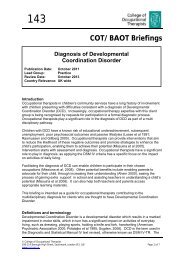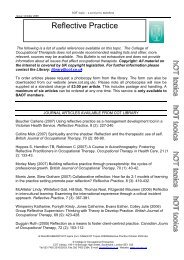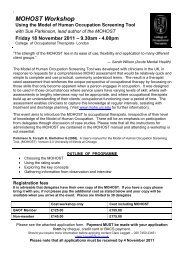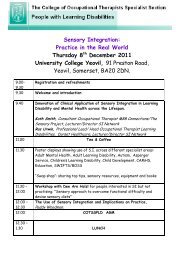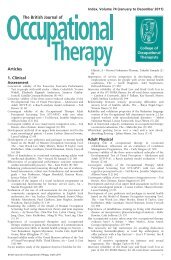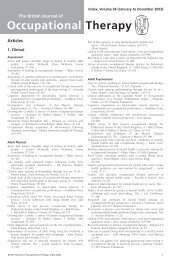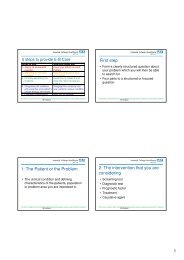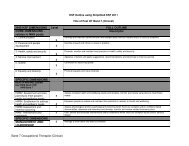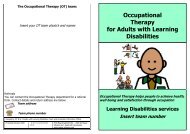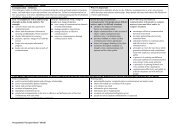Total hip replacement - College of Occupational Therapists
Total hip replacement - College of Occupational Therapists
Total hip replacement - College of Occupational Therapists
You also want an ePaper? Increase the reach of your titles
YUMPU automatically turns print PDFs into web optimized ePapers that Google loves.
Appendix 5: Evidence- based review tables<br />
Source Design and participants Intervention Outcomes Results Quality and comment<br />
Malik et al (2002) Case description<br />
Describes three service users<br />
who, in the immediate postoperative<br />
period, dislocated<br />
their THRs<br />
All three service users, two<br />
female and one male (aged 77,<br />
40 and 64), underwent<br />
Charnley THR via the Hardinge<br />
approach. All had no cerebral<br />
dysfunction, no radiological<br />
evidence <strong>of</strong> component<br />
malposition and leg length<br />
discrepancies <strong>of</strong> less than<br />
1 centimetre<br />
<strong>Total</strong> <strong>hip</strong> <strong>replacement</strong>. Dislocation. Service users dislocated at 14, 19<br />
and 23 days post- operatively, when<br />
turning to answer the telephone. It<br />
was assumed that the dislocation<br />
was due to postural reasons<br />
The authors recommend that when<br />
discussing <strong>hip</strong> precautions and<br />
performance <strong>of</strong> activities <strong>of</strong> daily<br />
living post- operatively, specific<br />
mention should be made regarding<br />
the need to place the telephone in<br />
an easily accessible location, and<br />
think <strong>of</strong> safe limb positioning prior<br />
to automatically using the<br />
telephone without prior thought.<br />
Grade D – Very Low<br />
Limitations:<br />
• Descriptive only<br />
• Case series but very limited<br />
information provided.<br />
United Kingdom.<br />
Mancuso<br />
et al (2003)<br />
Cross- sectional design<br />
Aim: measure service user preoperative<br />
expectations <strong>of</strong> THR,<br />
and to assess whether<br />
expectations vary by<br />
demographic characteristics<br />
and functional status<br />
n=1103<br />
Primary unilateral or bilateral<br />
THR<br />
Mean age 65 ± 13 years<br />
Male: female ratio = 43%:57%<br />
United States <strong>of</strong> America.<br />
<strong>Total</strong> <strong>hip</strong> <strong>replacement</strong><br />
– unilateral or bilateral.<br />
Self- reported preoperatively:<br />
• Hospital for special<br />
surgery total <strong>hip</strong><br />
<strong>replacement</strong><br />
expectations survey<br />
• American Academy <strong>of</strong><br />
orthopaedic surgeons<br />
<strong>hip</strong>/knee module<br />
• SF- 36® – general health<br />
scale.<br />
Significant evidence that decreased<br />
status pre- operatively results in<br />
greater expectation <strong>of</strong> THR surgery<br />
and greater importance on postoperative<br />
achievement <strong>of</strong> goals<br />
Pain relief and improvement in<br />
walking were most prevalent<br />
expectations<br />
• Service users with worse <strong>hip</strong><br />
function had more expectations<br />
compared with patients who had<br />
better <strong>hip</strong> function (p=0.0001)<br />
• Similarly, service users who had<br />
worse overall physical health had<br />
more expectations compared with<br />
service users who had better<br />
physical health (p=0.0001)<br />
• Service users with worse function<br />
were particularly more likely to<br />
expect relief <strong>of</strong> night pain and to<br />
not need medications compared<br />
with service users who had better<br />
function (p=0.001).<br />
Grade C – Low<br />
Limitations<br />
• Allocation unclear<br />
• Possible bias through selfreporting<br />
• Co- morbidities not included<br />
in analysis<br />
• Single setting<br />
• Not controlled for severity<br />
<strong>of</strong> pre- operative condition<br />
• Unclear if differences<br />
existed in pre- operative<br />
discussion about<br />
expectations between<br />
surgeons and service users.<br />
<strong>College</strong> <strong>of</strong> <strong>Occupational</strong> <strong>Therapists</strong><br />
91



